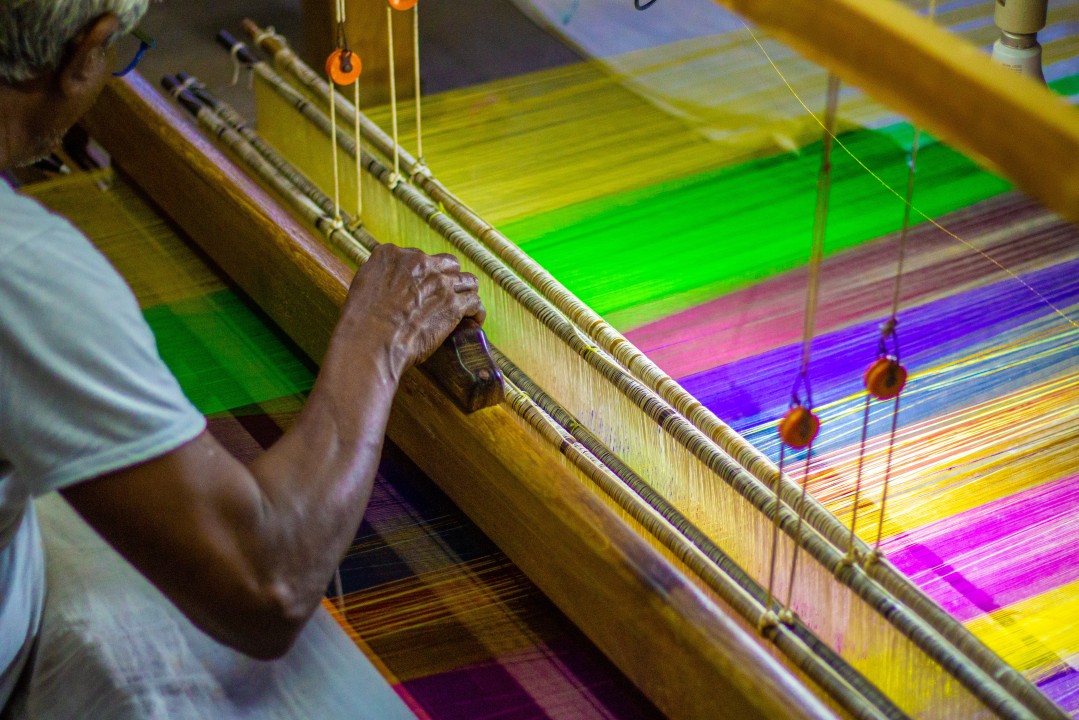
From Loom to Legacy: Tracing the History of Weaving
Share
You might be curious about what handlooms are and what handloom weaving entails. In essence, a handloom is a device constructed from wooden frames of various sizes. Skilled weavers use this device to create fabrics from natural fibres like jute, cotton, wool, and silk. The handloom is manually operated and does not require electricity, making it an exceptionally eco-friendly method of textile production.
The weaving process involves interlacing two sets of threads, known as 'the warp' and 'the weft,' to form the fabric. These fabrics are crafted using multi-coloured threads on a wide range of looms, capable of producing anything from simple fabrics to intricate designs and artwork. Common handloom products include sarees, dhotis, shawls, bed sheets, and curtains.
Exploring the Diverse World of Handloom Fabrics
Banarasi Handloom Fabric
Origin: Varanasi, Uttar Pradesh Details: Banarasi silk is renowned for its intricate designs and luxurious feel. Traditionally woven with gold or silver zari threads, these fabrics often feature elaborate patterns inspired by Mughal art, such as floral and foliate motifs, kalga and bel, and a string of upright leaves called jhallar. Banarasi sarees are highly sought after for weddings and special occasions due to their opulence and craftsmanship.

Chanderi Handloom Fabric
Origin: Chanderi, Madhya Pradesh Details: Chanderi fabric is known for its lightweight, sheer texture, and fine luxurious feel. It is produced by weaving silk and golden zari into traditional cotton yarn, resulting in a shimmering texture. The fabric features motifs like peacocks, flowers, and geometric patterns, making it a popular choice for sarees and salwar kameez.
Maheshwari Handloom Fabric
Origin: Maheshwar, Madhya Pradesh Details: Maheshwari fabric is a blend of silk and cotton, known for its vibrant colours and intricate designs. The fabric is lightweight and airy, making it ideal for sarees and dupattas. Traditional motifs include checks, stripes, and floral patterns, often inspired by the architecture of Maheshwar.
Kanchipuram Handloom Fabric
Origin: Kanchipuram, Tamil Nadu Details: Kanchipuram silk is celebrated for its durability and lustrous finish. These sarees are woven from pure mulberry silk and feature rich gold borders and brocades. The designs often include traditional motifs like peacocks, temples, and floral patterns, making them a staple for bridal wear and festive occasions.
Tussar Silk Handloom Fabric
Origin: Jharkhand, West Bengal, Odisha Details: Tussar silk, also known as kosa silk, is valued for its rich texture and natural gold sheen. It is produced from silkworms that feed on oak and juniper leaves. Tussar silk is used in sarees, shawls, and other clothing items, known for its softness and unique texture.
Pochampally Handloom Fabric
Origin: Pochampally, Telangana Details: Pochampally fabric is famous for its intricate Ikat patterns, created by dyeing the yarns before weaving. This technique results in vibrant geometric designs that are highly prized worldwide. Pochampally sarees and fabrics are made from silk or cotton and are known for their durability and striking appearance.
Ikat Handloom Fabric
Origin: Andhra Pradesh, Odisha, Gujarat Details: Ikat is a resist dyeing technique where the yarns are dyed before weaving, resulting in bold and vibrant patterns. The characteristic blurriness of the designs is due to the difficulty in aligning the dyed yarns during weaving. Ikat fabrics are used for sarees, garments, and home decor.
Patola Handloom Fabric
Origin: Patan, Gujarat Details: Patola is a double Ikat weave, known for its intricate and colourful designs. The fabric is highly durable and often considered an heirloom. Patola sarees are traditionally worn during auspicious occasions and are prized for their craftsmanship and vibrant patterns
Handloom Weaving: Discovering India's Ancient Art
India has a 5,000-year-old tradition of handloom weaving. Early civilizations like the Indus Valley used handlooms to make essential items from natural fibers. These fabrics were also traded with Western civilizations.

Key Periods:
- Ancient and Medieval: Weaving was a sign of wealth, with intricate patterns valued by traders.
- Mughal Era: A golden age for textiles, with luxurious fabrics and advanced techniques.
- Colonial Period: Machine-made textiles impacted handlooms, but the Swadeshi movement revived them.
- Post-Independence: Efforts to promote and preserve handloom weaving continue, celebrating its cultural and sustainable value.
